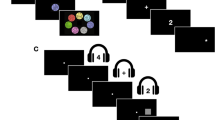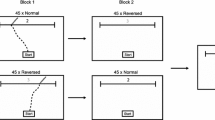Abstract
The present study investigated college students’ ability to estimate the results of multi-digit multiplication problems and the extent to which this ability improves with practice. Participants judged whether the results of multiplication problems composed of two-digit numbers were larger or smaller than a given reference number. The reference numbers were either close or far from the exact answer. The effects of practice, size, and distance of the reference number from the exact answer were examined using four measures of performance: speed, accuracy, eye movements, and strategy use. The results show that together with enhanced speed and accuracy with practice, participants also changed the pattern of eye movements and the strategies they used. The eye movement analysis showed longer dwell time and more frequent first fixations toward the reference number with practice, suggesting that participants relied more on the reference number to solve the task with practice. The strategy analysis revealed that with practice participants reduced their use of the approximate calculation strategy, which involves multiplying the rounded operands and comparing the product to the reference number, and increased their reliance on the sense of magnitude strategy which does not involve any calculation, but is grounded in the ANS. This was done especially for trials in which the reference number was far from the exact answer, thus exhibiting enhanced adaptivity in strategy choice with practice.






Similar content being viewed by others
References
Anderson, J. R., & Lebiere, C. (1998). The atomic components of thought. Mahwah: LEA.
Ansari, D. (2008). Effects of development and enculturation on number representation in the brain. Nature Reviews Neuroscience, 9(4), 278–291.
Ashcraft, M. H., & Stazyk, E. H. (1981). Mental addition: a test of three verification models. Memory and Cognition, 9, 185–196.
Cantlon, J., Platt, M. L., & Brannon, E. M. (2009). Beyond the number domain. Trends in Cognitive Sciences, 13(2), 83–91.
Corbetta, M., Akbudak, E., Conturo, T. E., Snyder, A. Z., Ollinger, J. M., Drury, H. A., et al. (1998). A common network of functional areas for attention and eye movements. Neuron, 21(4), 761–773.
De Corte, E., Verschaffel, L., & Pauwels, A. (1990). Influence of the semantic structure of word problems on second graders’ eye movements. Journal of Educational Psychology, 82(2), 359.
Dehaene, S. (1997). The number sense. New York: Oxford University Press.
Dehaene, S., Dehaene-Lambertz, G., & Cohen, L. (1998). Abstract representations of numbers in the animal and human brain. Trends in Neurosciences, 21(9), 355–361.
Delazer, M., Domahs, F., Bartha, L., Brenneis, C., Lochy, A., Trieb, T., et al. (2003). Learning complex arithmetic—an fMRI study. Cognitive Brain Research, 18, 76–88.
Dowker, A. (1997). Young children’s addition estimates. Mathematical Cognition, 3, 141–154.
Dowker, A., Flood, A., Griffiths, H., Harriss, L., & Hook, L. (1996). Estimation strategies of four groups. Mathematical Cognition, 2, 113–135.
Feigenson, L., Dehaene, S., & Spelke, E. (2004). Core systems of number. Trends in Cognitive Sciences, 8(7), 307–314.
Fias, W., Lammertyn, J., Reynvoet, B., Dupont, P., & Orban, G. A. (2003). Parietal representation of symbolic and nonsymbolic magnitude. Journal of Cognitive Neuroscience, 15(1), 47–56.
Ganor-Stern, D. (2015a). Can dyscalculics estimate the results of arithmetic problems? Journal of Learning Disabilities.
Ganor-Stern, D. (2015b). When you don’t have to be exact—investigating computation estimation skills with a comparison task. Acta Psychologica, 154, 1–9.
Geary, D. C. (1994). Children’s mathematical development. Washington, DC: American Psychological Association.
Geary, D. C., Brown, S., & Samaranayake, V. A. (1991). Cognitive addition: a short longitudinal study of strategy choice and speed-of-processing differences in normal and mathematically disabled children. Developmental Psychology, 27(5), 787–797.
Green, H. J., Lemaire, P., & Dufau, S. (2007). Eye movement correlates of younger and older adults’ strategies for complex addition. Acta Psychologica, 125(3), 257–278.
Hoffman, J. E., & Subramaniam, B. (1995). The role of visual attention in saccadic eye movements. Perception and Psychophysics, 57(6), 787–795.
Huber, S., Cornelsen, S., Moeller, K., & Nuerk, H.-C. (2015). Toward a model framework of generalized parallel componential processing of multi-symbol numbers. Journal of Experimental Psychology. Learning, Memory, and Cognition, 41(3), 732.
Huber, S., Mann, A., Nuerk, H.-C., & Möller, K. (2014a). Cognitive control in number magnitude processing: evidence from eye-tracking. Psychological Research, 78(4), 539–548.
Huber, S., Moeller, K., & Nuerk, H. C. (2014b). Adaptive processing of fractions—evidence from eye-tracking. Acta Psychologica, 148, 37–48.
Imbo, I., & Vandierendonck, A. (2008). Practice effects on strategy selection and strategy efficiency in simple mental arithmetic. Psychological Research, 72(5), 528–541.
Kallai, A., & Tzelgov, J. (2012). The place-value of a digit in multi-digit numbers is processed automatically. Journal of Experimental Psychology. Learning, Memory, and Cognition, 38(5), 1221–1233.
Kirk, E. P., & Ashcraft, M. H. (2001). Telling stories: the perils and promise of using verbal reports to study math strategies. Journal of Experimental Psychology. Learning, memory, and cognition, 27, 157–175.
LeFevre, J.-A., Greenham, S. L., & Waheed, N. (1993). The development of procedural and conceptual knowledge in computational estimation. Cognition and Instruction, 11, 95–132.
Lemaire, P., & Lecacheur, M. (2002). Children’s strategies in computational estimation. Journal of Experimental Child Psychology, 82, 281–304.
Lemaire, P., & Lecacheur, M. (2010). Strategy switch costs in arithmetic problem solving. Memory and Cognition, 38(3), 322–332.
Lemaire, P., Lecacheur, M., & Farioli, F. (2000). Children’s strategy use in computational estimation. Canadian Journal of Experimental Psychology, 54(2), 141–148.
Lemaire, P., & Siegler, R. (1995). Four aspects of strategic change: contributions to children’s learning of multiplication. Journal of Experimental Psychology: General, 124(1), 83–97.
Logan, G. (1988). Toward an instance theory of automatization. Psychological Review, 91, 295–327.
Lyons, I. M., Ansari, D., & Beilock, S. L. (2015a). Qualitatively different coding of symbolic and nonsymbolic numbers in the human brain. Human Brain Mapping, 36(2), 475–488.
Lyons, I. M., Nuerk, H. C., & Ansari, D. (2015b). Rethinking the implications of numerical ratio effects for understanding the development of representational precision and numerical processing across formats.
McEldoon, K. L., Durkin, K. L., & Rittle-Johnson, B. (2013). Is self-explanation worth the time? A comparison to additional practice. British Journal of Educational Psychology, 83(4), 615–632.
Merkley, R., & Ansari, D. (2010). Using eye tracking to study numerical cognition: the case of the ratio effect. Experimental Brain Research, 206(4), 455–460.
Moeller, K., Fischer, M., Nuerk, H., & Willmes, K. (2009). Sequential or parallel decomposed processing of two-digit numbers? Evidence from eye-tracking. Quarterly Journal of Experimental Psychology, 62(2), 323–334.
Moyer, R. S., & Landauer, T. K. (1967). Time required for judgments of numerical inequality. Nature, 215, 1519–1520.
Pinhas, M., Pothos, E. M., & Tzelgov, J. (2013). Zooming in and out from the mental number line: evidence for a number range effect. Journal of Experimental Psychology. Learning, Memory, and Cognition, 39(3), 972–976.
Rayner, K. (1998). Eye movements in reading and information processing: 20 years of research. Psychological Bulletin, 124(3), 372–422.
Rayner, K. (2009). Eye movements and attention in reading, scene perception, and visual search. The Quarterly Journal of Experimental Psychology, 62(8), 1457–1506.
Rehder, B., & Hoffman, A. B. (2005). Eyetracking and selective attention in category learning. Cognitive Psychology, 51(1), 1–41.
Schneider, W., Eschman, A., & Zuccolotto, A. (2002). E-Prime user’s guide. Pittsburgh: Psychology Software Tools Inc.
Siegler, R. S. (1996). Emerging minds. New York: Oxford University Press.
Siegler, R. S., & Booth, J. (2005). Development of numerical estimation: a review. In J. Campbell (Ed.), Handbook of mathematical cognition (pp. 197–212). New York: Psychology Press.
Siegler, R. S., & Lemaire, P. (1997). Older and younger adults’ strategy choices in multiplication: testing predictions of ASCM via the choice/no choice method. Journal of Experimental Psychology: General, 126, 71–92.
Siegler, R. S., & Shrager, J. (1984). A model of strategy choice. In C. Sophian (Ed.), Origins of cognitive skills (pp. 229–293). Hillsdale: Erlbaum.
Smith-Chant, B. L., & LeFevre, J. (2003). Doing as they are told and telling it like it is: Self-reports in mental arithmetic. Memory & Cognition, 31(4), 516–528.
Suppes, P. (1990). Eye-movement models for arithmetic and reading performance. Eye Movements and Their Role in Visual and Cognitive Processes, 4, 455–477.
Van Opstal, F., Gevers, W., De Moor, W., & Verguts, T. (2008). Dissecting the symbolic distance effect: comparison and priming effects in numerical and nonnumerical orders. Psychonomic Bulletin and Review, 15(2), 419–425.
Acknowledgments
This research was supported by the Israel Science Foundation to D.G.S. (Grant No. 906/12).
Author information
Authors and Affiliations
Corresponding author
Ethics declarations
Ethical standards
All procedures performed in studies involving human participants were in accordance with the ethical standards of the institutional and/or national research committee and with the 1964 Helsinki declaration and its later amendment or comparable ethical standards.
Additional information
D. Ganor-Stern and N. Weiss contributed equally to this manuscript.
Rights and permissions
About this article
Cite this article
Ganor-Stern, D., Weiss, N. Tracking practice effects in computation estimation. Psychological Research 80, 434–448 (2016). https://doi.org/10.1007/s00426-015-0720-7
Received:
Accepted:
Published:
Issue Date:
DOI: https://doi.org/10.1007/s00426-015-0720-7




